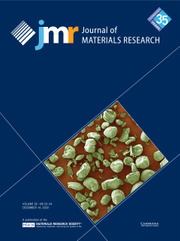Article contents
High resolution transmission electron microscopy of Ba1−xKxBiO3 superconductor-insulator-superconductor grain boundary tunnel junctions
Published online by Cambridge University Press: 31 January 2011
Extract
High angle boundaries in Ba1−xKxBiO3 are superconductor-insulator-superconductor (SIS) Josephson tunnel junctions of a quality unequaled among the high temperature superconducting oxides. Electron microscopy of 24° [001] tilt boundaries reveals nominally symmetric and straight boundaries of aperiodic structure with reappearing structural units. Low {hk0} atomistic facets are predominant. A segregation layer of only 1 nm thick is identified straddling the boundary. This layer which forms naturally is insulating, pin-hole free, and surprisingly robust with a breakdown voltage which exceeds 1 × 106 V/cm, yet thin enough to allow quasiparticle tunneling, yielding reliable gap energies for theoretical comparison.
Information
- Type
- Articles
- Information
- Copyright
- Copyright © Materials Research Society 1998
References
- 5
- Cited by

